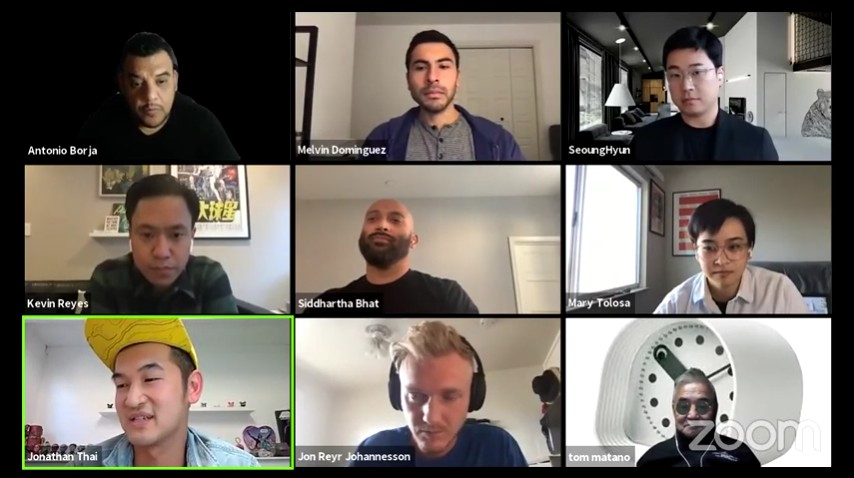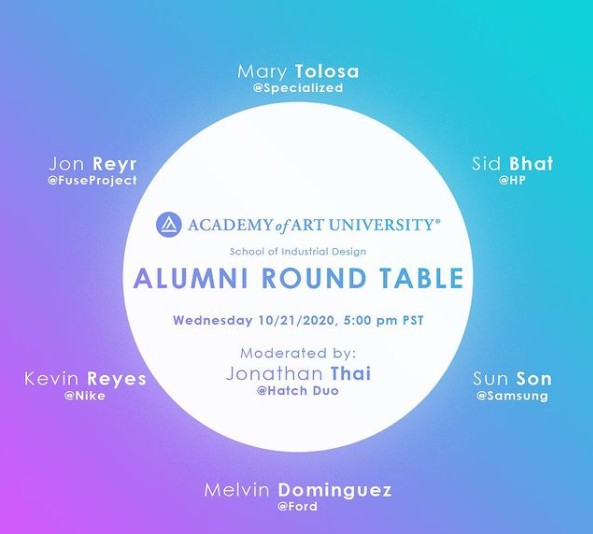By Nina Tabios
When asked what his biggest breakthrough was as a student, Nike Footwear Designer Kevin Reyes remembered it was during the summer when he had nothing to do.
“It was a rare summer where I had no offseason work to do. But by that point, you have your own self-conversation of knowing what your strengths are and what your weaknesses are,” Reyes said to the student audience that joined on Zoom. “So, I made a list and went at it. That’s when I realized that I really loved what I was doing.”
Reyes wasn’t the only one offering key insight and advice for students tuning in to the “Being a Successful Creative Designer” webinar on Wednesday, Oct. 21. Along with Reyes (B.F.A., 2014), the event brought in a group of School of Industrial Design (IND) graduates for an alumni roundtable discussion on all things design: Jonathan Thai (B.F.A., 2012), Siddhartha Bhat (B.F.A., 2012), Seounghyun “Sun” Son (B.F.A., 2011), Melvin Dominguez (B.F.A., 2012), Jon Reyr Johannesson (B.F.A., 2018), and Mary Tolosa (B.F.A., 2018) all joined in to collectively share their unique, individual stories and how their time at the Academy of Art University led them to roles at companies like Nike, Ford, Samsung, and Hewlett-Packard (HP).
Moderated by Thai, co-founder and industrial design principal for Hatch Duo, the conversation started with the habits and characteristics of designers like themselves. Throughout the discussion, the panelists, who all occupy different corners of the design world, talked shop on their design process, how to work within a company, and what drives them in their creativity.
“What defines a successful creative designer,” Thai asked his fellow alumni. “And under what conditions may those definitions vary?”
As a colors, materials, and finishes (CMF) designer for Specialized Bicycles, Tolosa believes good design is dependent on the customer. “It’s really understanding your consumer and also really thinking about research and trends and really telling that story through CMF on the products,” she said. “You need that emotional connection between the consumer and product.”

The rest of the panelists emphasized good design is also about selling the concept.
“To me, good designers are people who know how to rally around ideas, get the team around an idea, and be able to pitch that idea to move certain things forward,” said Dominguez, who is a member of the D-Ford team at Ford Motor Company, where he helps draw up products, services, and experiences for autonomous vehicles. “You have to sell ideas upward, especially to the executive levels.”
Thai’s follow-up question was, “What keeps you motivated?” To which Dominguez answered, “When you see something hit the shelves, it’s like your baby—never gets old.”
Bhat, who designs VR headsets for HP, echoed that same sentiment, “Taking something from my imagination and bringing it to physical form, it’s a feeling that never gets old and it motivates me every single day.”
Toward the end of the evening, students were encouraged to ask questions in the chat. Some of the questions asked about collaboration, new technologies, and sustainability. What IND student representative Santiago Bastidas wanted to know about was burnout: “How do you achieve a healthy work-life balance while working in a highly demanding field?”
Johannesson, who works for industrial design and branding firm fuseproject, said, “Pick your moments of when you’re working really late nights. It’s going to affect your work if you’re not enjoying your life.”
Sun, a lead industrial designer for wearables at Samsung Design Innovation Center, added that it’s important to turn to your colleagues. “Have healthy conversations with other designers and don’t waste too much energy on people who don’t understand.”
Kim Semler, an industrial design student, wanted to know, “How do you manage criticisms of being a designer?”
In response, Bhat credited his Product Design 1 class with instructor Chris Myers: “I learned on day one, don’t take it personal. Everyone is working toward the same goal, so take critique internally and pump out better products every time.”
Reyes, too, attributed his “tough skin” to his formative time at the Academy. “You get used to it, it’s part of your training throughout your years at [IND]. They’re ‘battle-hardening’ you for the real world so you’re always focusing on the next thing.”
While they touched upon a number of different topics, many students wanted to know the most important thing: how to land a job.
Sun mentioned variety in design language and an understanding of the process, which should be included in a portfolio. But he also mentioned the importance of team chemistry and personality, which both Baht and Reyes supported.
“Everyone interviews the new person,” Bhat said. “They want to see that you’re adding value, ‘Is this person coming in and bringing in fresh ideas?’”
“You should have a well-rounded set of skillsets, from sketching, modeling, working with a team of designers,” Reyes said. “But you also need to have teachability, accountability. Being a nice guy still counts in the world.”
Panels like these help students contextualize what’s waiting for them in the professional world. For Bastidas, it was interesting to see how everyone’s journey was so different, yet he could see the patterns in what makes a successful designer.
“Everyone had different jobs and titles, but it was all around the same passion for design,” Basitdas said. “As a student, I think [these conversations] are a great viewport into what your own future could be. It’s helpful to see if this is where they really want to be and if so one can really engage on specifics about the journey to get there.”
Watch the full IND Alumni Roundtable webinar below.
